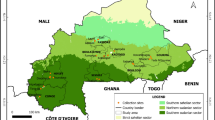Abstract
The genetic diversity of Poa annua L.populations collected from western Oregon grass-seed fields was surveyed using 18 randomly amplified polymorphic DNA (RAPD) markers. Markers from 1357 individual plants from 47 populations collected at three sampling dates (fall, winter, and spring) for 16 sites were used to measure genetic diversity within and among populations. Site histories varied from low to high herbicide selection pressure, and some sites were subdivided by 3 years of differing post-harvest residue management. Gene diversity statistics, simple frequency of haplotype occurrence, and analysis of molecular variance (AMOVA) revealed the presence of significant variability in P. annua among sites, among collection dates within sites, and within collection dates. Nei gene-diversity statistics and population-differentiation parameters indicated that P. annua populations were highly diverse. Mean Nei gene diversity (h) for all 47 populations was 0.241 and total diversity (HT) was 0.245. A greater proportion of this diversity, however, was within (HS=0.209) rather than among (GST=0.146) populations. When populations were grouped by season of collection, within-group diversity was HS=0.241, while among-group diversity was GST=0.017. When populations were grouped by site, within-group diversity was HS=0.224, while among-group diversity was GST=0.087. The diversity among populations within season for fall, winter, and spring collections was GST=0.121, 0.142, and 0.133, respectively. Populations collected from fields with histories of high herbicide selection pressure showed low differentiation among collection dates, with GST as low as 0.016, whereas those collected from fields with low herbicide selection pressure showed greater differentiation among collection dates, with GST as high as 0.125. At high selection-pressure sites, populations were also lower in gene diversity (as low as h=0.155), while at low selection-pressure sites there was higher gene diversity (as high as h=0.286). The site to site variability was greater for the high selection-pressure sites (GST=0.107 or 69% of the total among-population variance), while the season of germination variability was greater at sites of low herbicide-selection pressure (GST=0.067, or 70% of the total among-population variance). High initial diversity coupled with a long-term re-supply of genotypes from the seed bank must have been factors in maintaining the genetic diversity of this weed despite the intensive use of herbicides. Knowledge of the genetic diversity of Willamette Valley P. annua should help in formulating more effective strategies for managing this weed.
Similar content being viewed by others
Author information
Authors and Affiliations
Additional information
Received: 24 July 1999 / 11 November 1999
Rights and permissions
About this article
Cite this article
Mengistu, L., Mueller-Warrant, G. & Barker, R. Genetic diversity of Poa annua in western Oregon grass seed crops. Theor Appl Genet 101, 70–79 (2000). https://doi.org/10.1007/s001220051451
Issue Date:
DOI: https://doi.org/10.1007/s001220051451




